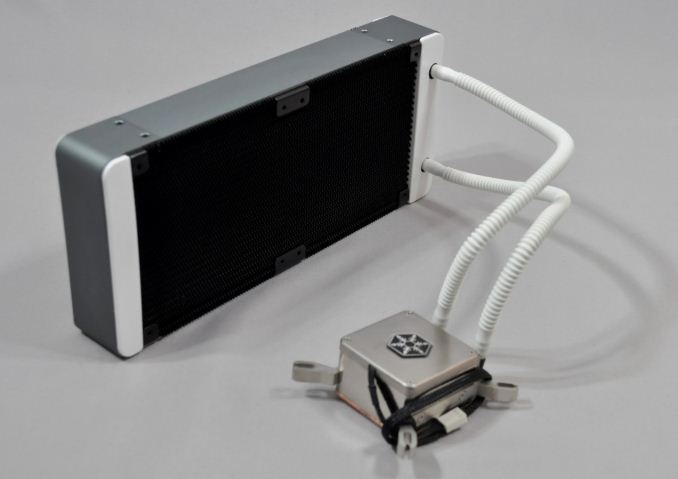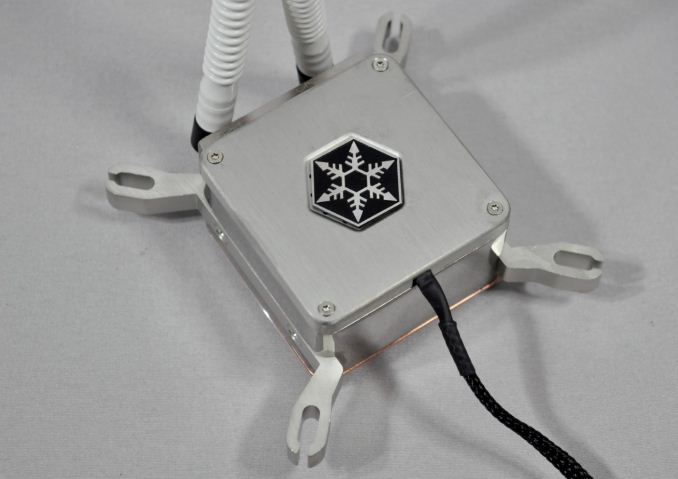Closed Loop AIO Liquid Coolers: 14-way Mega Roundup Review
by E. Fylladitakis on February 12, 2014 7:00 AM ESTSilverstone
Silverstone is another well-known name amongst advanced users and enthusiasts. The company earned their reputation from their first PSUs and original case designs and soon diversified towards cooling related products. They currently offer just two AIO liquid cooling solutions, the Tundra series. The company shipped both of them to us for this review.
Silverstone Tundra TD02
Silverstone ships the Tundra TD02 inside a large cardboard box with a black/blue theme. The box has plenty of pictures and information about the cooler printed on all of its sides. The company also supplies a fairly standard bundle with the Tundra TD02, which consists of a manual with installation instructions, mounting hardware and a syringe with thermal compound. There also is a 3-pin Y-splitter fan cable included, which can be used to power two fans off a single header. Silverstone supplies two 120mm fans with the TD02. The fans have back frames and curved, notched white blades that supposedly reduce aerodynamic noise, as well as fluid-state bearings for prolonged life. Their speed range is rather narrow, ranging from 1500 to 2500 RPM.
Visually, the Silverstone Tundra TD02 certainly stands out a lot. Although it is somewhat different, the Tundra TD02 could be coming from the same OEM that makes the Enermax Liqtech 120X as well; however, Silverstone did not want to reveal their source. The very large and deep radiator with the grey aluminum frame stands out, the size of which overwhelms any Asetek/CoolIT design. Size is not always a good thing though, as the 45mm thick design could bring serious compatibility issues, especially if the case has been designed with 27-29mm radiators in mind.
The design of the radiator is quite different from that of most other kits. Like the radiator of the Liqtech 120X, instead of wavy aluminum fins between the liquid pass-through channels, this design forms single, "seamless" fins from one side to the other, which are soldered onto the channels. The design of the fins and the overall size of the radiator though is different.
The block-pump assembly of the Tundra TD02 stands out over that of most other kits as well. It is entirely metallic, made of nickel-plated aluminum with a copper base. A badge with Silverstone's logo lies in the middle of the aluminum cap, which also has very subtle blue LEDs surrounding it. There is something unique about this block however; unlike any other assembly, including that of the Liqtech 120X, the copper base of the block is not attached to the assembly with screws, leaving the bottom of the block entirely plain. It has also been machined down to a perfect, smooth finish. The only thing that we could complain about is the use of narrow, stiff, white corrugated tubing, which is beneath the quality of such a product.
Silverstone Tundra TD03
Confusing as this may be, the Tundra TD03 actually is a smaller version of the TD02. It comes in a similarly designed cardboard box with a black/blue color theme, only it's significantly smaller. Despite the change in size however, the cooler remains very well protected within cardboard packaging and inside nylon bags. It also shares exactly the same bundle with the TD02, including the manual with the installation instructions. The two 120mm fans supplies are the same as those of the TD02, with a black frame and curved, notched white blades.
Both visually and practically, the Tundra TD03 is just a shorter version of the TD02. The radiator also shares the same design, and is just as wide and thick as the radiator of the TD02, yet nearly half as long, which means that it essentially has half the heat dissipation surface. Nevertheless, Silverstone still supplies two 120mm fans, to be used in a push-pull configuration. It is interesting to note that this radiator design appears a lot more solid, without any imperfections or bent fins, which appear to be very common on radiators with wavy aluminum fins.
As expected, the fully metallic block-pump assembly of the Tundra TD03 is identical to that of the TD02. The top and frame of the assembly are made out of nickel-plated aluminum, with the base of the block made out of solid copper. Even the mounting braces are made of solid aluminum, with those meant for Intel CPUs preinstalled on the block from the factory. Once again, the copper base is not attached to the aluminum frame with screws, at least not screws visible from the bottom of the assembly, leaving the base of the cooler perfectly clean and smooth.
























139 Comments
View All Comments
zodiacfml - Thursday, February 13, 2014 - link
Nice job. I like the various loads given to the coolers. Unfortunately, my interest in liquid coolers becomes less as Intel has been lowering the TDP of their CPUs.prateekprakash - Thursday, February 13, 2014 - link
I only wished they'd included Swiftech's H220 and H320 (Even though they aren't available in the US, but I've have been using H220 in my system here in India)buffhr - Thursday, February 13, 2014 - link
Why wasnt the swiftech H220 included in this list? Would of been really nice to see it stack up against 340W and well it is an AIO and meets up with the same price range as well.Rob94hawk - Sunday, February 16, 2014 - link
Because the H220 is a piece of crap due to mass pump failure. I'm on my 3rd one within warranty and I haven't even put it on yet. I have the stock cooler on my 4770k. That's how much confidence I have in the Swiftech H220.Suuave - Thursday, February 13, 2014 - link
A very interesting article but I have a suggestion of one thing would have definitely made it better - a chart. Give us a simple visual reference of "potential cooling performance" vs "noise level" vs "unit size" vs "price" that would give everyone a quick reference of the overall values for the features they are looking for in a sealed system.vgray35@hotmail.com - Thursday, February 13, 2014 - link
What we sorely need is a table of computer cases with a list of water coolers that fit into each case. A valuable reference that does not exist anywhere as far as I know. The reviewers are in the best position with their knowledge to provide such a table.Hrel - Thursday, February 13, 2014 - link
Would have been great if you guys could have included 1-3 air coolers in this review. For comparison.If you don't overclock and primarily care about noise liquid coolers make no sense at all. My air cooler never exceeds 16db. Apparently 36db is the lowest any of these go. That's simply TERRIBLE.
The PC Apologist - Thursday, February 13, 2014 - link
Would have been great if you read through the comments section...Just saying.
Daeros - Thursday, February 13, 2014 - link
This is really bothering me; this article strongly implies that sound pressure equates linearly to to loudness. The decibel scale is logarithmic, true, but while 3db is roughly a doubling in sound energy, it is the smallest difference reliably discernible as louder by people. It takes roughly a 10db increase in sound pressure to have a doubling in perceived loudness. In the example, the 30db difference would be perceived as (roughly) 8 times louder (3 doublings), not 1000 times louder (even though it may be 1000x as much energy).cactusdog - Friday, February 14, 2014 - link
I don't understand why cooler reviews are done with different speed fans, it makes no sense for comparison.